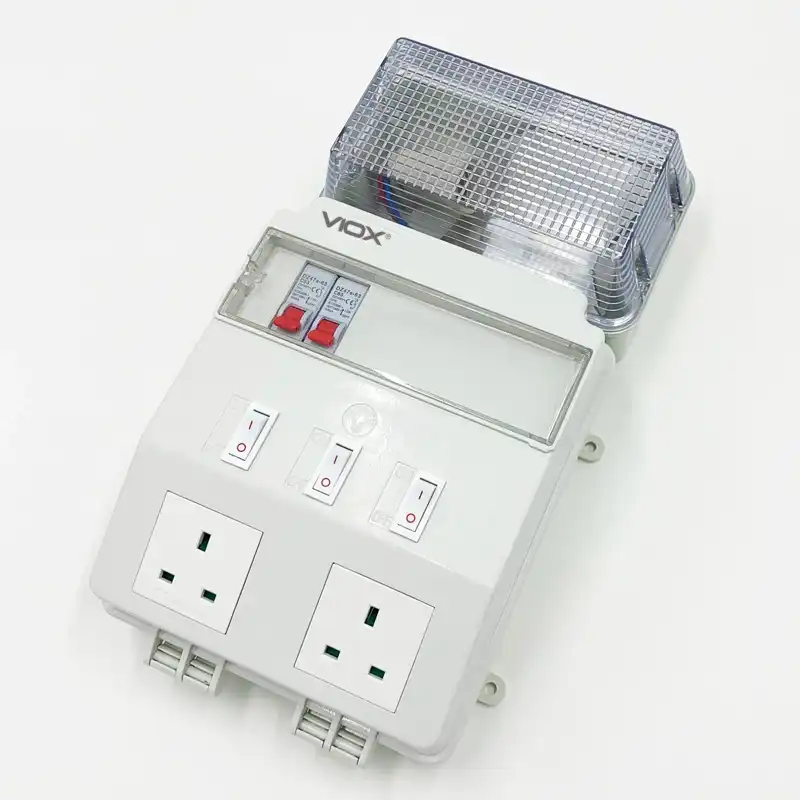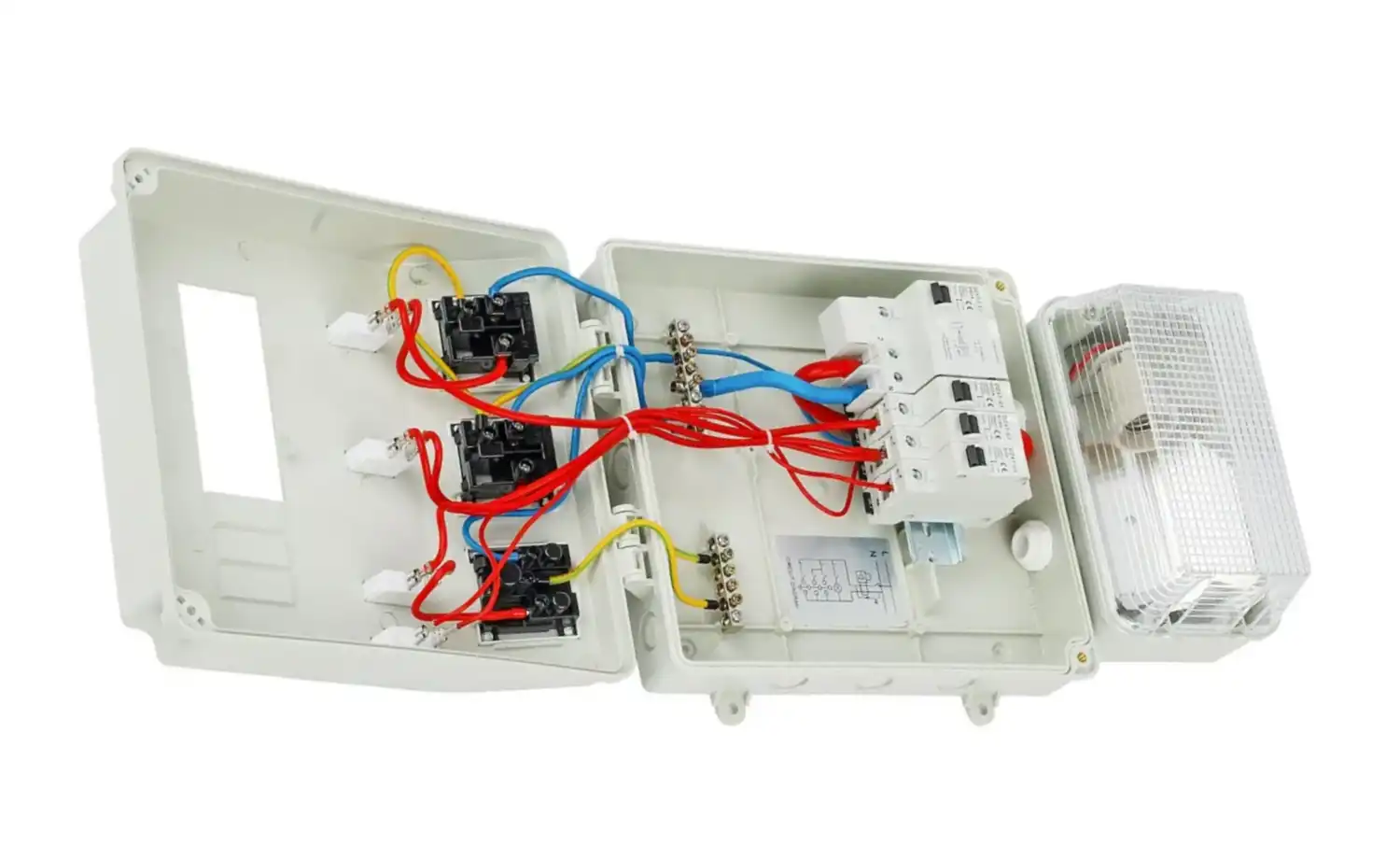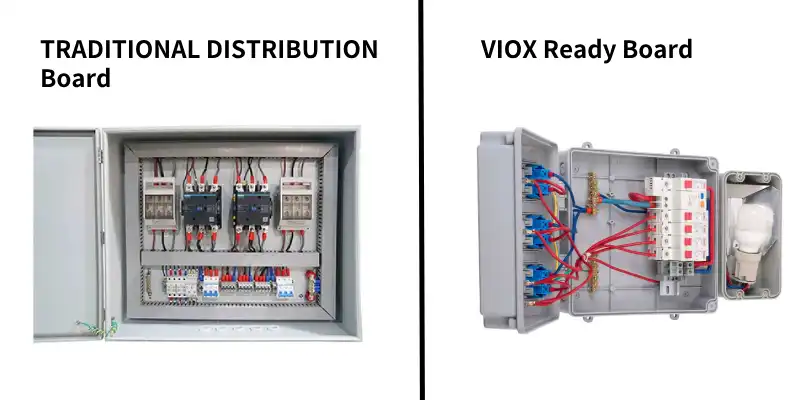Що таке готова дошка?
A Готова дошка це попередньо змонтована система розподілу електроенергії, призначена для базового електропостачання в житлових або громадських приміщеннях, особливо корисна в районах з обмеженою інфраструктурою. Ці компактні пристрої поставляються повністю зібраними з основними компонентами, такими як розетки, перемикачіта тримачі для ламп, що усуває необхідність у прокладанні великої електричної проводки в приміщенні.

Готові дошки розроблені для швидкого монтажу, що вимагає лише підключення заземлення для безпеки. Це робить їх ідеальними для швидкого розгортання електричного доступу в невеликих будівлях, як правило, з двома кімнатами або менше. Електроживлення розподіляється від Ready Board до різних точок за допомогою подовжувачів, що забезпечує гнучкість без необхідності прокладання постійної електропроводки.
Основна перевага готових дощок полягає в їх економічності та простоті використання. Відсутність потреби в традиційній електричній проводці значно скорочує витрати і час на встановлення. Це робить їх особливо придатними для тимчасового житла, притулків на випадок надзвичайних ситуацій або районів, що розвиваються, де швидка електрифікація має вирішальне значення.
Компоненти готової дошки

- Головний вимикач: Керує загальним блоком живлення, дозволяючи вмикати та вимикати його.
- Автоматичний вимикач: Автоматично відключає живлення в разі короткого замикання.
- Система захисту від витоків струму на землю: Забезпечує безпеку в разі витоку електрики.
- Велика лампа: Забезпечує освітлення приміщення, де встановлена готова дошка.
- Три розетки:
- Ліва сторона: Для підключення важких електроприладів, таких як плити, за допомогою подовжувача.
- Середній: Для підключення приладів середньої потужності, таких як праски, за допомогою подовжувача.
- Права сторона: Для підключення легких електроприладів, таких як радіоприймачі, телевізори, вентилятори тощо, через подовжувач.
- Блок обліку: Постачається разом із готовою платою для вимірювання споживання електроенергії.

Переваги готових дощок у порівнянні з традиційними методами дистрибуції

Готові дошки та традиційні методи розподілу електроенергії суттєво відрізняються за дизайном, функціональністю та застосуванням. Ready Boards - це компактні системи з попередньо підключеними проводами, призначені для швидкого встановлення, що робить їх ідеальними для швидкого розгортання в житлових або громадських приміщеннях з базовими потребами в електропостачанні. Вони вимагають мінімального налаштування, а для безпеки потрібне лише заземлення. На відміну від них, традиційні розподільні щити передбачають складніші процеси встановлення, розраховані на більш високі навантаження і зазвичай використовуються в промислових умовах.
Функціонально Ready Boards слугують низьковольтними розподільчими пристроями з базовими захисними функціями, спрямованими насамперед на забезпечення ефективного та сталого електропостачання в районах з недостатньо розвиненою інфраструктурою. Традиційні щити, натомість, керують кількома ланцюгами з комплексними механізмами захисту, що підходить для більш складних електричних систем.
Готові дошки знаходять свою нішу в громадах з низьким рівнем доходу, сільській місцевості або тимчасових установках, тоді як традиційні дошки краще підходять для постійного встановлення в житлових, комерційних і промислових приміщеннях з різноманітними електричними потребами. Компактний дизайн Ready Boards дозволяє ефективніше використовувати простір, що робить їх придатними для невеликих житлових приміщень, тоді як традиційні дошки можуть потребувати більше місця через свою складність.
Встановлення дошки побутової готовності
Перед встановленням готової плати уважно перевірте упаковку, корпус та ущільнювальні гвинти на наявність пошкоджень. Якщо плата зберігалася протягом тривалого періоду або має ознаки пошкодження, зверніться до уповноваженого відділу для повторної перевірки. Почніть процес встановлення, вимкнувши живлення та перевіривши напругу за допомогою тестера, щоб переконатися, що струм не протікає. Виберіть сухе, добре провітрюване місце, подалі від води та легкозаймистих матеріалів, дотримуючись місцевих електротехнічних норм і правил.
Надійно прикріпіть готову дошку до стіни, забезпечивши її вертикальне та стійке положення. Підключіть головний провід живлення до вимикача, дотримуючись відповідного кольорового маркування (червоний - позитивний, синій - нейтральний, жовто-зелений - заземлення). Встановіть відповідні автоматичні вимикачі та акуратно прокладіть дроти, уникаючи нещільних з'єднань або перехресного з'єднання. Промаркуйте кожне коло для легкої ідентифікації та подальшого обслуговування.
Перед початком експлуатації перевірте номінальний струм і напругу кожного компонента на відповідність технічним характеристикам. Проведіть пробний запуск, щоб перевірити функціональність усіх перемикачів і вимикачів. Дуже важливо уникати ударів по готовій платі твердими предметами та утримуватися від заміни оригінальних компонентів нестандартними деталями. Ведіть докладні записи про будь-які проблеми, що виникли під час використання, і повідомте про них виробника, якщо це необхідно.
Задля безпеки та дотримання нормативних вимог, ми наполегливо рекомендуємо, щоб установку та періодичне обслуговування виконував професійний електрик. Це забезпечить правильну проводку, надійні з'єднання та ефективну роботу вашої готової плати.
Готові дошки в Африці: Огляд та еволюція ринку
Ринок готових плит в основному зосереджений в Африці, особливо в країнах на південь від Сахари, які дотримуються європейських стандартів розподілу електроенергії (240 В, 50 Гц). Південно-Африканська Республіка є епіцентром виробництва, оптової та роздрібної торгівлі готовою продукцією. Дослідження ринку показують, що ці продукти були спеціально розроблені для африканських ринків та подібних юрисдикцій.
Концепція готових дощок виникла з потреби забезпечити електроенергією мешканців неформальних поселень у щільній міській забудові південноафриканських міст. З часом їх використання поширилося на інші африканські країни, зокрема Уганду, Замбію, Танзанію, Ліберію та Кенію.
Спочатку готові електрощитки, виготовлені для африканського ринку, були малопотужними пристроями, призначеними для дуже бідних громад. Зазвичай вони мали одну розетку та одну лампочку, що задовольняло базові потреби в електриці. Однак ринок еволюціонував, і зараз доступні більш потужні електрощитки. Ці вдосконалені моделі знаходять застосування не лише в житлових приміщеннях, а й у господарських будівлях, складах і гаражах, пропонуючи альтернативу традиційним внутрішнім системам електропроводки.
У той час як на африканському ринку готового картону домінують місцеві виробники та постачальники, такі як CBi У Південній Африці нові гравці виходять на ринок з інноваційними рішеннями. Наприклад, Yueqing VIOX Electric Co,.Ltd тепер пропонує готові плати, які усувають обмеження традиційних моделей. Їхню продукцію можна налаштувати відповідно до конкретних вимог, включаючи малосерійне виробництво та адаптацію до різних стандартів інтерфейсів, як британських, так і північноамериканських. Така гнучкість у дизайні та виробництві допомагає задовольнити різноманітні потреби африканського ринку та інших країн.
Інформація надходить від https://pdf.usaid.gov/pdf_docs/PA00MGF5.pdf
Найкращі виробники готових щитів трансформують електрифікацію в Африці
Зростання популярності готових дощок в Африці можна пояснити не лише їхніми численними перевагами, але й внеском провідних виробників, які надають високоякісні та надійні рішення. Нижче наведені деякі з провідних виробників, які мають значний вплив на ринку:
VIOX Electric Co, Ltd.
Огляд: Цей виробник пропонує готові дошки, що налаштовуються на замовлення і підходять для різних ринків, зокрема й для Африки. Гнучкість дизайну та прихильність до якості роблять їх надійним вибором.
Веб-сайт: VIOX Electric
CBi Electric
Огляд: CBi Electric - провідний виробник з Південної Африки, що спеціалізується на низьковольтних електророзподільчих пристроях, включаючи готові плати. Орієнтація на якість та інновації зробили компанію піонером у цій галузі.
Веб-сайт: CBi Electric
MCE Electric
Огляд: MCE Electric пропонує широкий асортимент електротехнічної продукції, ключовим компонентом якої є готові плати. Вони надають пріоритет якості та безпеці, роблячи свою продукцію придатною для різних застосувань.
Веб-сайт: MCE Electric
Allbro
Огляд: Відома своїми інноваційними електричними рішеннями, компанія Allbro розробляє готові плати, пристосовані до місцевих умов Південної Африки. Продукція компанії відома своєю довговічністю та адаптивністю.
Веб-сайт: Allbro
ВИСНОВОК
Готові дошки стали життєво важливим рішенням для швидкої електрифікації в регіонах, що розвиваються, особливо в Африці. Ці готові системи забезпечують швидкий монтаж, економічну ефективність та базові функції безпеки, що робить їх ідеальним рішенням для тимчасового житла та громад з обмеженою інфраструктурою. З розвитком ринку готові електрощити стають все більш досконалими, задовольняючи ширший спектр застосувань, що виходять за рамки базового житлового використання. Не замінюючи комплексні електричні системи, готові дошки слугують важливою сходинкою у забезпеченні доступу до електроенергії. Їх подальший розвиток і впровадження обіцяють відігравати значну роль у вирішенні глобальних проблем електрифікації, сприяючи підвищенню рівня життя в регіонах з недостатнім рівнем обслуговування. Однак для забезпечення безпеки та ефективності їхньої роботи важливими залишаються належна установка та обслуговування кваліфікованими фахівцями.
Пов'язана стаття:
Готові дошки проти традиційних розподільчих щитів
Виготовлення електричних готових плат
Переваги готових дощок для зовнішнього використання


